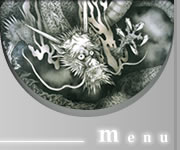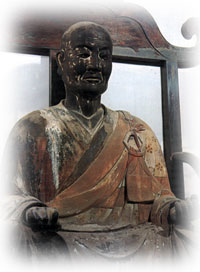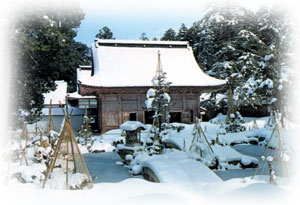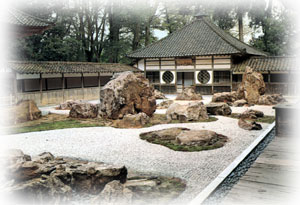

|
Top >
Head Temples - Kokutai-ji Temple
Head TemplesTemple Name: Kokutai-ji 國泰寺Mountain Name: Machozan 摩頂山Address: 184 Ota, Takaoka-shi, Toyama-ken, 933-0133 Japan
 Kokutai-ji was established by Jiun Myoi 慈雲妙意 (1274–1345). Jiun as a young
monk had lived in a hut on Mount Futakami, south of where Kokutai-ji is
presently located, practicing meditation as a hermit. The monk Koho Kakumyo
孤峰覺明 (1271–1361), who happened to be on pilgrimage in the area, suggested
that he visit the Zen master Shinchi Kakushin 心地覺心 (1207–1298), who was
Kakumyo’s own teacher. Jiun followed this advice, traveling to Kakushin’s
temple, Kokoku-ji 興國寺, located in Yura in present Wakayama Prefecture. Jiun
stayed with Kakushin until, at the age of twenty-four, he experienced a deep
enlightenment. Receiving Kakushin’s sanction, he returned to his hut on
Mount Futakami and continued his practice. In 1300 Jiun founded the temple
Tosho-ji 東松寺 there, attracting a large number of disciples from throughout
the land. Subsequently he won the support of Emperor Go-Daigo 後醍醐 (r.
1319–1339), who in 1327 awarded him a purple robe and the honorary title
Seisen Zenji 清泉禪師, and who bestowed upon his temple the imperial name Kokutai-ji
國泰寺, the Temple of National Peace, with a rank equal to that of Nanzen-ji in Kyoto. The temple was, furthermore, included among the
Ankoku-ji 安國寺 (Temples for National Peace) system established by the
Ashikaga shogunate, at the request of the Northern Dynasty emperor Komyo 光明
(r. 1336–1348). In 1345 Jiun passed away, leaving the death verse, “In the
heavens, the moon; on the earth, a spring.” He was awarded the posthumous
title Enichi Shoko Kokushi 慧日聖光國師 by Emperor Komyo. Kokutai-ji was established by Jiun Myoi 慈雲妙意 (1274–1345). Jiun as a young
monk had lived in a hut on Mount Futakami, south of where Kokutai-ji is
presently located, practicing meditation as a hermit. The monk Koho Kakumyo
孤峰覺明 (1271–1361), who happened to be on pilgrimage in the area, suggested
that he visit the Zen master Shinchi Kakushin 心地覺心 (1207–1298), who was
Kakumyo’s own teacher. Jiun followed this advice, traveling to Kakushin’s
temple, Kokoku-ji 興國寺, located in Yura in present Wakayama Prefecture. Jiun
stayed with Kakushin until, at the age of twenty-four, he experienced a deep
enlightenment. Receiving Kakushin’s sanction, he returned to his hut on
Mount Futakami and continued his practice. In 1300 Jiun founded the temple
Tosho-ji 東松寺 there, attracting a large number of disciples from throughout
the land. Subsequently he won the support of Emperor Go-Daigo 後醍醐 (r.
1319–1339), who in 1327 awarded him a purple robe and the honorary title
Seisen Zenji 清泉禪師, and who bestowed upon his temple the imperial name Kokutai-ji
國泰寺, the Temple of National Peace, with a rank equal to that of Nanzen-ji in Kyoto. The temple was, furthermore, included among the
Ankoku-ji 安國寺 (Temples for National Peace) system established by the
Ashikaga shogunate, at the request of the Northern Dynasty emperor Komyo 光明
(r. 1336–1348). In 1345 Jiun passed away, leaving the death verse, “In the
heavens, the moon; on the earth, a spring.” He was awarded the posthumous
title Enichi Shoko Kokushi 慧日聖光國師 by Emperor Komyo.
|

 The temple suffered a
decline during the era of the warfare that continued from the 1470s until
the 1550s, particularly during the incursions of the forces under the
warlord Uesugi Kenshin 上杉謙信 (1530–1578). However, the temple was restored in
the mid-sixteenth century by the twenty-eighth abbot, Settei Shukuyo 雪庭祝陽,
at the request of Emperor Go-Nara 後奈良 (r. 1526–1557).
The temple suffered a
decline during the era of the warfare that continued from the 1470s until
the 1550s, particularly during the incursions of the forces under the
warlord Uesugi Kenshin 上杉謙信 (1530–1578). However, the temple was restored in
the mid-sixteenth century by the twenty-eighth abbot, Settei Shukuyo 雪庭祝陽,
at the request of Emperor Go-Nara 後奈良 (r. 1526–1557). The year 1580 appears
to have been the time when Kokutai-ji was moved from its original location
on Mount Futakami to its present site. The Daihojo building was constructed
in 1686, and the Tokugawa shogunate designated Kokutai-ji the headquarters
of the Hatto school of Rinzai Zen. In the 1720s a large renovation of the
buildings was carried out; the present Dharma Hall dates from this time. The
temple felt the effects of the government’s anti-Buddhist policies following
the Meiji Restoration in 1868, but the abbots Etsuju 越受 and Setsumon 雪門 were
able to restore many of the temple buildings with the aid of the imperial
advisor and master swordsman Yamaoka Tesshu 山岡鐵舟 (1836–1888). Setsumon was
also one of the earliest Zen teachers to the famous scholars Nishida Kitaro
西田幾多郎 (1870–1945) and Suzuki Daisetsu 鈴木大拙 (1870–1966). Kokutai-ji remains
the largest Zen monastery in the Hokuriku region, maintaining a formal
training hall (sodo) and opening its doors to meditation students both
lay and ordained.
The year 1580 appears
to have been the time when Kokutai-ji was moved from its original location
on Mount Futakami to its present site. The Daihojo building was constructed
in 1686, and the Tokugawa shogunate designated Kokutai-ji the headquarters
of the Hatto school of Rinzai Zen. In the 1720s a large renovation of the
buildings was carried out; the present Dharma Hall dates from this time. The
temple felt the effects of the government’s anti-Buddhist policies following
the Meiji Restoration in 1868, but the abbots Etsuju 越受 and Setsumon 雪門 were
able to restore many of the temple buildings with the aid of the imperial
advisor and master swordsman Yamaoka Tesshu 山岡鐵舟 (1836–1888). Setsumon was
also one of the earliest Zen teachers to the famous scholars Nishida Kitaro
西田幾多郎 (1870–1945) and Suzuki Daisetsu 鈴木大拙 (1870–1966). Kokutai-ji remains
the largest Zen monastery in the Hokuriku region, maintaining a formal
training hall (sodo) and opening its doors to meditation students both
lay and ordained.